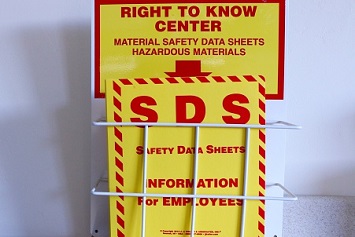In a letter of interpretation dated August 3, 2018, U.S. OSHA’s Directorate of Enforcement Programs provided several valuable insights into the extent chemical manufacturers, distributors, or importers may make use of trade secret protections when completing safety data sheets (SDSs), formerly material safety data sheets (MSDSs).
Under OSHA’s Hazard Communication Standard ((HCS), 29 CFR 1910.1200(g)), these entities must provide an SDS for each hazardous chemical to downstream users to communicate information on the hazards. An SDS includes information such as the properties of the hazardous chemicals; the physical, health, and environmental health hazards; protective measures; and safety precautions for handling, storing, and transporting the chemical.
Required Information
The letter of interpretation responds to questions a company asked about Section 3 of the SDS, which requires information on the ingredients contained in the product indicated on the SDS. For mixtures, Section 3 states that the responsible entity must provide the chemical name and concentration (i.e., exact percentage) of all ingredients that are classified as health hazards, that are present above their cutoff/concentration limits, or that pose a health risk below the cutoff/concentration limits. The Section adds that the exact percentage of each ingredient must be specified; however, concentration ranges may be used if a trade secret claim is made, there is batch-to-batch variation, or the SDS is used for a group of substantially similar mixtures.
Exact Percentages
The questioner was primarily concerned about the extent of trade secret protections applicable to percentages of ingredients. In its response, OSHA made the following points:
- A manufacturer or importer may not claim trade secret status for a concentration range and is prohibited from masking the true range by using a wider range. If a concentration range is used on the SDS, it must be limited in terms of the percentage concentration variation (i.e., the narrowest range possible), and the variation in concentration must have no effect on the hazard of the mixture. The HCS does not prohibit the use of symbols, such as = or <, to identify a range of values in place of the exact percentage as long as the range does not include zero percentage (0%) and represents the narrowest range possible; however, the symbol “~” (i.e., approximate or about) may not be used. (OSHA does not allow the use of 0% as an ingredient’s exact percentage or as part of a concentration range on an SDS because this may be misinterpreted to mean that a particular ingredient in a mixture is not present when in actuality it is.)
- It is not appropriate to leave the concentration percentage (or identity of the ingredient(s)) blank in Section 3. Where a trade secret is claimed, a statement that the specific chemical identity and/or exact percentage (concentration) of composition has been withheld as a trade secret is required in Section 3. If the exact percentage of a hazardous ingredient in a mixture is considered a trade secret, a concentration range may be used in its place.
- Use of the term “exact percentage” in Section 3 means a discrete number. Concentration ranges are allowed, however, in certain circumstances; for example, when there is batch-to-batch variability in the production of a mixture or when there is a group of substantially similar mixtures with similar chemical composition.
OSHA’s letter also answers several questions about how to fill out SDSs when the exact chemical concentrations are not known and about grouping together multiple ingredients that have similar hazards.
OSHA’s letter of interpretation is at https://www.osha.gov/laws-regs/standardinterpretations/2017-08-03-1.

